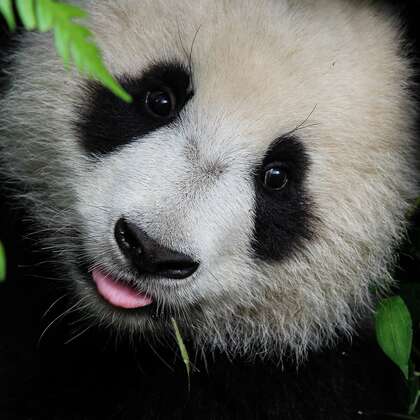The giant panda is China’s national treasure. It is recognized as a symbol of China throughout the world. The giant panda lives in the mountains of central China, especially in the misty forests of western Sichuan province. Due to habitat loss and poaching, giant pandas were once endangered and considered rare exotic animals. Thanks to conservation efforts and forest protection, giant pandas were downlisted from ‘endangered’ to ‘vulnerable’ by the IUCN in 2016.
Giant pandas belong to the bear family but they are more closely related to bears, not the polar bear which they resemble. An adult giant panda can weigh up to 150 kg and resemble a cuddly plaything. However, giant pandas must forage for 12 to 16 hours a day in order to get enough energy from their bamboo diet to sustain their large size. They spend at least 12 hours a day eating as their digestive system is designed for a carnivore yet suited to a strictly herbivore diet of bamboo.
A giant panda’s striking black and white coat provides effective camouflage in the snow and shade of dense bamboo groves. The black hair on its ears, eye patches, legs and shoulders is dense and silky, while the white hair is soft and long. This unique coloration which is rare among animals has made the giant panda a world-famous endangered species and premier conservation symbol.
Due to deforestation and habitat fragmentation, giant pandas only inhabit isolated pockets within mountain ranges in central China’s Sichuan, Shaanxi and Gansu provinces. The total population of wild giant pandas is around 1,800. Nearly 300 giant pandas live in captivity within breeding centers and zoos, many of which are in China. The Chengdu Panda Breeding and Research Center is the world’s leading giant panda breeding facility which began captive breeding in the 1980s. It has significantly increased the population of captive giant pandas and accounts for over half the world’s captive pandas.
The giant panda is an unofficial national symbol of China and one of the most beloved animals. Its unique charisma has made the giant panda an icon for wildlife conservation and environmental protection. China has gifted giant pandas to countries as a “panda diplomacy” gesture to symbolize friendship and cooperation. The giant panda reflects China’s efforts in saving endangered species and natural heritage. Though once rare and endangered, giant pandas have become a sign of hope that conservation can achieve incredible victories if we work together to protect nature and our planet’s biodiversity.
The giant panda is China’s most iconic animal symbol and a conservation success story. Once rare and endangered, giant pandas have been protected by captive breeding programs and forest conservation. Their unique black and white markings and playful charm have made giant pandas beloved ambassadors for wildlife protection and China’s national treasure.











